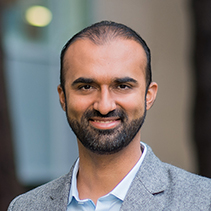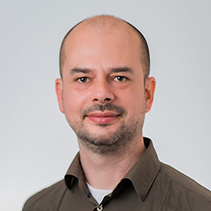Brain Focused Ultrasound: A New Era of Image-guided Neuro-intervention
A UCSF team that includes members of the Department of Radiology and Biomedical Imaging, is addressing new clinical and research neuro applications of High Intensity Focused Ultrasound (HIFU) and Low Intensity Focused Ultrasound (LIFU).

"From the outset we wanted the UCSF Focused Ultrasound in Neuroscience Program to be multidisciplinary with close ties between the clinical and research arms," says Leo Sugrue, MD, PhD, associate professor who co-directs UCSF’s clinical program in focused ultrasound with Doris Wang, MD PhD, assistant professor in the Department of Neurological Surgery. Dr. Sugrue, Kazim Narsinh, MD, assistant professor and neurointerventional radiologist, Eugene Ozhinsky, PhD, assistant professor, Kisoo Kim, PhD, postdoctoral scholar, and Tommaso Di Ianni, PhD, recently hired assistant professor in the Department of Psychiatry, will present their work on brain applications of HIFU and LIFU in a webinar on March 28 at noon PDT.
“We traditionally think of ultrasound in terms of its uses in imaging parts of the body,” says Dr. Sugrue. “‘Focused’ ultrasound concentrates ultrasound waves at a particular location in order to deliver energy in a targeted manner to a particular part of the body to produce a physiological effect.”

His presentation will introduce the Focused Ultrasound in Neuroscience Program and describe how he is using HIFU clinically to treat Essential Tremor, the most common movement disorder, by ablating a specific part of the thalamus – an important structure deep in the brain. Dr. Sugrue will explain the key role that imaging plays in guiding these treatments and ensuring excellent tremor reduction while minimizing potential side effects.

Dr. Narsinh’s talk will explain applications of LIFU in Neuro Oncology. LIFU is an innovative technique that uses low intensity and lower frequency US to produce non-thermal effects on the target tissue. One specific use of LIFU is to temporarily change the permeability of the blood brain barrier, a specialized barrier that protects the brain, so that anti-cancer drugs can be delivered in high concentrations to brain tumors. Another application is to allow liquid biopsy – the genotyping of tumors based on tumor DNA circulating in the blood – which has the potential to replace invasive tissue biopsy.
 Eugene Ozhinsky, PhD and Kisoo Kim, PhD will discuss their current research which focuses on an important research area: MR techniques to monitor focused ultrasound imaging effects on the brain in real time. Specifically, they are developing advanced thermometry (in the case of thermal ablation) and perfusion and diffusion-based MR imaging techniques (in the case of the blood brain barrier opening). Dr. Kim says that while MRI technologies have improved, there is still a need for further development to advance MR-guided focused ultrasound in the brain.
Eugene Ozhinsky, PhD and Kisoo Kim, PhD will discuss their current research which focuses on an important research area: MR techniques to monitor focused ultrasound imaging effects on the brain in real time. Specifically, they are developing advanced thermometry (in the case of thermal ablation) and perfusion and diffusion-based MR imaging techniques (in the case of the blood brain barrier opening). Dr. Kim says that while MRI technologies have improved, there is still a need for further development to advance MR-guided focused ultrasound in the brain.
 Dr. Tommaso Di Ianni’s talk will provide an overview of promising research using LIFU for neuromodulation – modifying the activity of brain circuits in neuropsychiatric applications. Although LIFU is not yet used clinically to treat neuropsychiatric disorders, ongoing research is exploring its use in clinical applications that this modality could potentially address. Some of the disorders that are currently being investigated for ultrasound neuromodulation treatment are Major Depression, Obsessive Compulsive Disorder, sleep disorders and substance abuse.
Dr. Tommaso Di Ianni’s talk will provide an overview of promising research using LIFU for neuromodulation – modifying the activity of brain circuits in neuropsychiatric applications. Although LIFU is not yet used clinically to treat neuropsychiatric disorders, ongoing research is exploring its use in clinical applications that this modality could potentially address. Some of the disorders that are currently being investigated for ultrasound neuromodulation treatment are Major Depression, Obsessive Compulsive Disorder, sleep disorders and substance abuse.
According to Dr. Di Ianni, LIFU neuromodulation has the potential to provide a new tool for noninvasive mapping of brain circuits in individual patients – allowing for personalized targeting of circuit-based treatments with either focused ultrasound or more traditional approaches like Deep Brain Stimulation.
